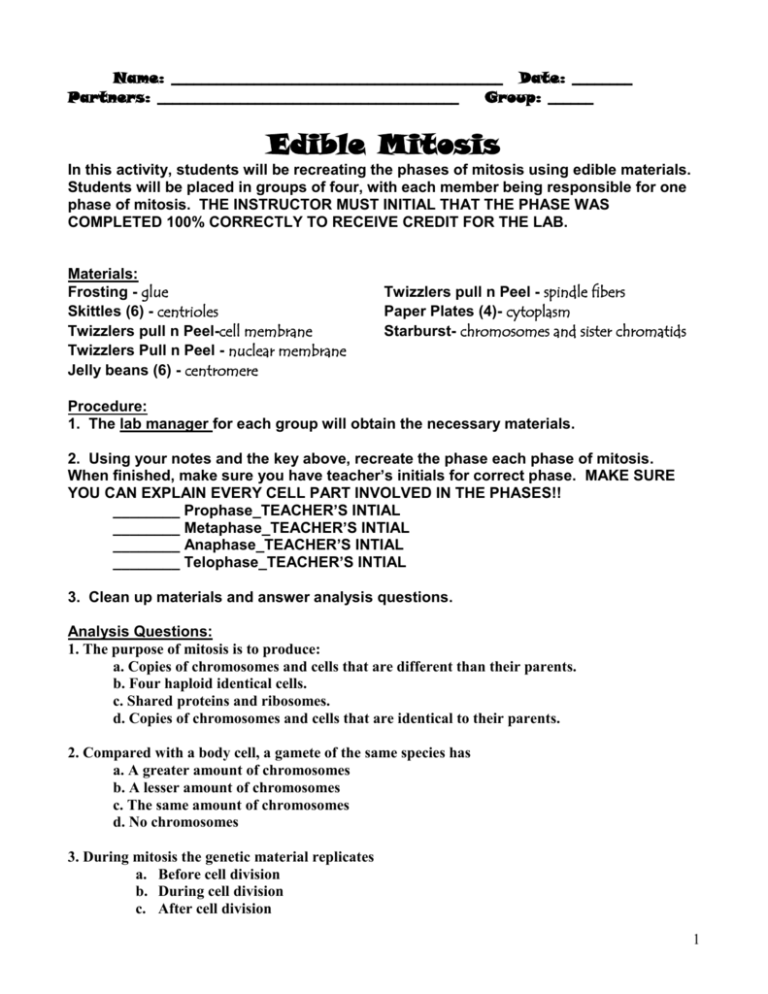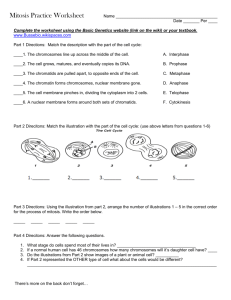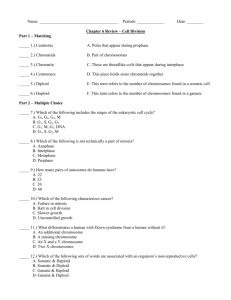Names
advertisement

Name: ____________________________________________ Date: ________ Partners: ________________________________________ Group: ______ Edible Mitosis In this activity, students will be recreating the phases of mitosis using edible materials. Students will be placed in groups of four, with each member being responsible for one phase of mitosis. THE INSTRUCTOR MUST INITIAL THAT THE PHASE WAS COMPLETED 100% CORRECTLY TO RECEIVE CREDIT FOR THE LAB. Materials: Frosting - glue Skittles (6) - centrioles Twizzlers pull n Peel-cell membrane Twizzlers Pull n Peel - nuclear membrane Jelly beans (6) - centromere Twizzlers pull n Peel - spindle fibers Paper Plates (4)- cytoplasm Starburst- chromosomes and sister chromatids Procedure: 1. The lab manager for each group will obtain the necessary materials. 2. Using your notes and the key above, recreate the phase each phase of mitosis. When finished, make sure you have teacher’s initials for correct phase. MAKE SURE YOU CAN EXPLAIN EVERY CELL PART INVOLVED IN THE PHASES!! ________ Prophase_TEACHER’S INTIAL ________ Metaphase_TEACHER’S INTIAL ________ Anaphase_TEACHER’S INTIAL ________ Telophase_TEACHER’S INTIAL 3. Clean up materials and answer analysis questions. Analysis Questions: 1. The purpose of mitosis is to produce: a. Copies of chromosomes and cells that are different than their parents. b. Four haploid identical cells. c. Shared proteins and ribosomes. d. Copies of chromosomes and cells that are identical to their parents. 2. Compared with a body cell, a gamete of the same species has a. A greater amount of chromosomes b. A lesser amount of chromosomes c. The same amount of chromosomes d. No chromosomes 3. During mitosis the genetic material replicates a. Before cell division b. During cell division c. After cell division 1 d. Never occurs 4. Chromatids are held together by a (n) a. Protein b. Centromere c. Spindle d. Aster 5. If a cell has 48 chromosomes, how many chromosomes will each daughter cell have after mitosis occurs? a. 96 b. 12 c. 24 d. 48 6. The phase of mitosis that is characterized by the lining up of chromosomes in the middle of the cell is known as: a. Prophase b. Metaphase c. Anaphase d. Telophase 7. When there are two sets of chromosomes the cell is said to be a. Homogenous. b. Heterogeneous. c. Haploid. d. Diploid. 8. Mitosis is a process by which a. Gametes are formed b. Cytokinesis occurs c. Cells grow d. A cell’s nucleus divides 9. The diploid number of chromosomes in a human skin cell is 46. The number of chromosomes found in a human gamete is a. 23 b. 92 c. 46 d. 12.5 10. What is the difference between chromatin and chromosomes? 11. What type of cells are involved in mitosis? Give an example. 12. What type of cells ARE NOT involved in mitosis? Give an example. 2 13. What is the diploid number in humans? What is the abbreviation for diploid? 14. What is the haploid number in humans? What is the abbreviation for haploid? 15. In what phase of mitosis is the nuclear membrane still in tact? __________________________ 16. In what phase of mitosis do the sister chromatids separate? __________________________ 17. In what phase of the cell cycle does cell growth and DNA replication occur? _______________ 18. Do somatic cells have the haploid or diploid number of chromosomes? ___________________ 19. In what phase does the nuclear membrane reappear? ________________________ 20. What type of cells have a haploid number of chromosomes? __________________________ 21. Label the following diagram 3







